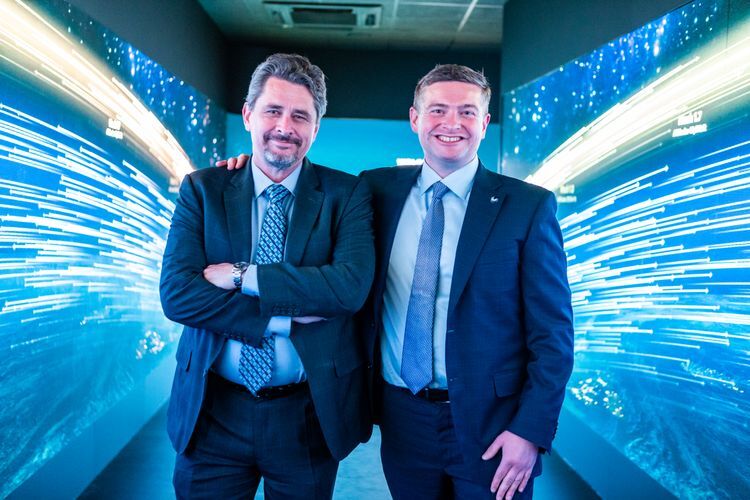Military variants of a civilian supersonic airliner already on the cards
The first of the next generation of civilian supersonic flight is yet to arrive, but military variants are already being considered. Northrop Grumman and Boom Supersonic signed an agreement at the Farnborough International Air Show to develop special quick-reaction mission variants of Boom’s Overture supersonic aircraft.
When the last Concorde supersonic passenger liner made its final flight in 2003, the aerospace sector flew into a technological hiatus not seen since the end of the Apollo missions. As the Anglo-French aircraft touched the tarmac for the last time, the world lost an entire class of capability, which was the ability to fly passengers and cargo in sustained flight across intercontinental distances at well over the speed of sound.
There were many reasons this happened, but a generation later civilian supersonic flight is coming back as more economical designs jump off the drawing boards to the production floor with new fuselage and wing technologies that will minimize the infamous sonic boom.
One of the contenders in this race is Boom Supersonics, which is working on its 200-ft (71-m) long Overture supersonic liner capable of carrying up to 80 passengers at speeds of Mach 1.7 over water and Mach 0.94 over land. That supersonic cruise speed would be twice as fast as conventional airliners, allowing for flights of four and a half hours from Tokyo to Seattle.
Northtrop Grumman
The Overture is scheduled to make its maiden flight in 2026 and enter into service by 2029, but the new agreement with Northrop Grumman indicates that the US military and allied nations are interested in new variants suitable for rapid response missions for the military and government. Such crossovers between military and civilian aircraft are common arrangements that go back decades.
Because the ink on the agreement isn’t even dry, details on the collaboration are still scarce on the ground, but the new variants could be used for missions to transport troops, deliver medical supplies, carry out medical evacuations, and for reconnaissance missions to monitor large areas.
“Pairing Northrop Grumman’s airborne defense systems integration expertise with Boom’s advanced Overture supersonic aircraft demonstrates the power of collaborations like this for the benefit of our customers,” said Tom Jones, president, Northrop Grumman Aeronautics Systems. “Together we can ensure our military customers have variants of Overture for missions where advanced system capabilities and speed are critical.”
Source: Northrop Grumman
The first of the next generation of civilian supersonic flight is yet to arrive, but military variants are already being considered. Northrop Grumman and Boom Supersonic signed an agreement at the Farnborough International Air Show to develop special quick-reaction mission variants of Boom’s Overture supersonic aircraft.
When the last Concorde supersonic passenger liner made its final flight in 2003, the aerospace sector flew into a technological hiatus not seen since the end of the Apollo missions. As the Anglo-French aircraft touched the tarmac for the last time, the world lost an entire class of capability, which was the ability to fly passengers and cargo in sustained flight across intercontinental distances at well over the speed of sound.
There were many reasons this happened, but a generation later civilian supersonic flight is coming back as more economical designs jump off the drawing boards to the production floor with new fuselage and wing technologies that will minimize the infamous sonic boom.
One of the contenders in this race is Boom Supersonics, which is working on its 200-ft (71-m) long Overture supersonic liner capable of carrying up to 80 passengers at speeds of Mach 1.7 over water and Mach 0.94 over land. That supersonic cruise speed would be twice as fast as conventional airliners, allowing for flights of four and a half hours from Tokyo to Seattle.

Northtrop Grumman
The Overture is scheduled to make its maiden flight in 2026 and enter into service by 2029, but the new agreement with Northrop Grumman indicates that the US military and allied nations are interested in new variants suitable for rapid response missions for the military and government. Such crossovers between military and civilian aircraft are common arrangements that go back decades.
Because the ink on the agreement isn’t even dry, details on the collaboration are still scarce on the ground, but the new variants could be used for missions to transport troops, deliver medical supplies, carry out medical evacuations, and for reconnaissance missions to monitor large areas.
“Pairing Northrop Grumman’s airborne defense systems integration expertise with Boom’s advanced Overture supersonic aircraft demonstrates the power of collaborations like this for the benefit of our customers,” said Tom Jones, president, Northrop Grumman Aeronautics Systems. “Together we can ensure our military customers have variants of Overture for missions where advanced system capabilities and speed are critical.”
Source: Northrop Grumman
